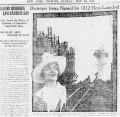Click On Image
For Full Size Image |
Size |
Image Description |
Contributed
By And/Or Copyright |
 |
106k | Jacob Jones was born in Delaware in March 1768. Initially educated in the field of medicine, he was employed as clerk of the Delaware Supreme Court before joining the Navy in 1799 as a Midshipman. During the Quasi-War with France, he served under Commodore John Barry in the frigate United States and was promoted to the rank of Lieutenant in 1801. Jones was an officer of the frigate Philadelphia when that ship was taken by the Tripolitans in 1803. Held captive for nearly two years, he again had seagoing service after his release and, with the rank of Master Commandant, took command of the sloop of war Wasp in 1810. In October 1812, during the early months of the War of 1812, Jones took Wasp on an Atlantic cruise. Despite storm damage to his ship, he attacked a British convoy on 18 October and, following an intense battle, captured the Royal Navy sloop of war Frolic. Both combatants were seriously damaged and soon fell victim to the powerful ship of the line Poictiers, but Jones' achievement was widely admired. Returning to the United States after an exchange of prisoners, he received a gold medal from the Congress, was promoted to the rank of Captain and given command of the frigate Macedonian. With his ship blockaded at New York, Captain Jones was sent to the Lake Ontario theatre, where he commanded the frigate Mohawk during the last year of the war. During the final Barbary War, in 1815, Jacob Jones again commanded Macedonian. Service as Captain of the frigate Guerriere followed in 1816-1818. He was Commodore of the United States' squadrons in the Mediterranean in 1821-1823 and in the Pacific in 1826-1829. Jones was a Navy Commissioner in Washington, D.C., between those tours at sea and held important commands ashore at Baltimore and New York during the 1830s and 1840s. He received final assignment, as commandant of the Naval Asylum at Philadelphia in 1847. Commodore Jacob Jones held that position at the time of his death on 3 August 1850. The U.S. Navy has named two destroyers and an escort ship in honor of Jacob Jones, including: USS Jacob Jones (Destroyer # 61), 1916-1917; USS Jacob Jones (Destroyer # 130, later DD-130), 1919-1942; and USS Jacob Jones (DE-130), 1943-1973. Photo #: NH 48739. Captain Jacob Jones, USN, crayon portrait by Albert Rosenthal, 1918, after a painting by Rembrandt Peale. The artist presented this portrait to USS Jacob Jones (Destroyer # 130).
U.S. Naval Historical Center Photograph. | Bill Gonyo |
 |
383k | Newspaper clipping from the New York Tribune dated May 30 1915. | Mike Mohl |
 |
108k | Newspaper clipping from the Washington Times dated November 11 1917 of the ship's sponsor. | Mike Mohl |
 |
52k | 1915, location unknown. | Robert Hurst |
 |
99k | Starboard view, 1916 image. | USN |
 |
145k | Starboard view, circa 1916. | Dave Wright |
 |
96k | USS Melville (Destroyer Tender # 2) tending U.S. Navy destroyers at Queenstown, Ireland, 1917. The destroyers present include (from left to right): USS Jacob Jones (Destroyer # 61); USS Ericsson (Destroyer # 56); USS Wadsworth (Destroyer # 60); and an unidentified ship. U.S. Naval Historical Center Photograph. | Fred Weiss |
 |
111k | USS Jacob Jones (Destroyer # 61) sinking off the Scilly Islands, England, on 6 December 1917, after she was torpedoed by the German submarine U-53. Photographed by Seaman William G. Ellis. Smithsonian Institution Photograph. | Fred Weiss |
 |
101k | USS Jacob Jones (Destroyer # 61) Ship's survivors following their rescue. Jacob Jones was sunk off the Scilly Isles by the German submarine U-53, on 6 December 1917. Courtesy of Commander Donald J. Robinson, USN (Retired), 1981. U.S. Naval Historical Center Photograph. | Fred Weiss |
 |
262k | Newspaper clipping covering the loss of the Jacob Jones (DD-61) in World War I and the Jacob Jones (DD-130) in World War II. | Ron Reeves |


 64 of her crew were lost and remain on duty.
64 of her crew were lost and remain on duty.